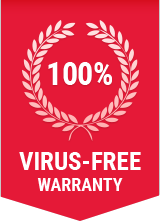What is updater.exe?
Originally developed by Moodlogic, updater.exe is a legitimate file process that is associated with Moodlogic Application. It is located in C:\Program Files by default.
updater.exe virus is created when malware authors write virus files and name them after updater.exe with an aim to spread virus on the internet.
Affected Platform: Windows OS
How to check if your computer is infected with updater.exe malware?
If your system is affected by updater.exe malware, you will notice one or the several below symptoms:
updater.exe occupies an unusually large CPU memory
- Erratic internet connection
- Your browser is bombarded with annoying popup ads
- Computer screen freezes
- PC's processing speed suffers
- You are redirected to unknown websites
To pinpoint the virus file location, take the following steps:
Step 1: Press CTRL+ALT+DEL keys at once to open Task Manager.
Step 2: If you notice the file located outside C:\Program files you should run an antivirus scan to get rid of the malware.
How to remove updater.exe malware from system using Comodo Cleaning Essentials?
You can either choose to remove updater.exe and other malwares using Comodo Antivirus, or Comodo Cleaning Essentials (CCE) – both of which are absolutely free to download! CCE is a set of computer security tools designed to help you identify and remove malwares and unsafe processes from an infected computer.
To remove malwares using CCE, take the following steps:
1. Check the system requirements and download the feature-rich CCE suite for free.
2. After installation, choose the type of scan you want to perform. CCE offers 3 scan options to get rid of malwares from a PC:
- Smart Scan: Does a scan on critical areas of your system.
- Full Scan: Does a complete scan of your system.
- Custom Scan: Does a scan only on selected items.
The process to initiate the above mentioned scans are self-explanatory and thus, easy-to-use.
Additionally, it's recommended that you approve of any updates that the CCE will prompt you about to ensure it does a better job of identifying all
the latest threats.
3. Click 'Next' to view the results.
Regardless of the type of scan you choose, the results will sometimes show false positive (flagging files that are actually safe), which has to be ignored. Only select the files you want to get rid of.
4. Click 'Apply' to apply the selected operations to the threats. The selected operations will be applied.
| No. | Company | File Type | SHA1 | MD5 | Malware Name |
Digitally Signed |
File Version |
Product Version |
Submitted From |
Malware Behavior |
|---|
- 4 items per page
- 8 items per page
- 16 items per page
- 32 items per page
| No. | Company | File Type | SHA1 | MD5 | Digitally Signed |
File Version |
Product Version |
Submitted From |
|---|---|---|---|---|---|---|---|---|
| 1 | Mozilla Foundation | Executable | 5818c034d9998303 a657185f17daed2c 0fea8d57 |
a0b9e7de47350366 22e25684eef31b21 |
Yes | 147.0a1 | 147.0a1 |  United States United States |
| 2 | Mozilla Foundation | Executable | 7eb71bc08c3b1811 d78092f3e10dfbd4 b4a3ee93 |
c73237f4f140f1b9 09d5def55ee4e1c2 |
Yes | 145.0.1 | 145.0.1 |  United States United States |
| 3 | Corporation for Digital Scholarship | Executable | 4e0ce3acd63c1730 403497214ea535fb 097d45c8 |
e3fed5cd524e74be 5b2415f008ad2d27 |
Yes | 7.0.27 | 7.0.27 |  United States United States |
| 4 | Analog Devices Inc. | Executable | 7e23b3bdadea7a8c a04c5d936b60e309 489b8389 |
aaa4521cde32c6c2 4f7a353f5e9c8c89 |
No | 24.1.10.4 | 24.1.10.4 |  United States United States |








